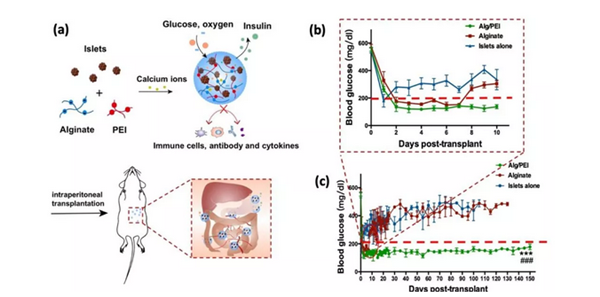TJU scientist develops promising new type of hydrogel T1DM treatment
Tianjin University is posing a promising treatment for 30 million patients worldwide suffering from type 1 diabetes mellitus (T1DM).
An anti-biofouling balanced charged hydrogel that can serve as an excellent imunoprotective material for islet transplantation therapy was developed by TJU research group led by Prof. Zhang Lei.
Based on the balanced charge strategy, Prof. Zhang’s team developed a novel anti-biofouling hydrogel that enables high efficient islet encapsulation, in vivo immune evasion, and rapid and long-term blood glucose control.
"The new type of balanced charged anti-biofouling hydrogel is low-cost and has a great potential to be widely used in biomedical and health fields, including cell therapy and tissue engineering," Prof. Zhang said.
It overcomes the long-standing challenge the area has faced. To start with, patients dealing with T1DM commonly rely on multiple daily exogenous insulin injections, but those may cause serious complications as well as a lot of pain.
Furthermore, although transplantation of encapsulated healthy islets is a promising strategy since it may achieve dynamic blood glucose control and insulin independence, its long-term clinical therapeutic efficacy is limited by the human body immune system.
Therefore, Prof. Zhang’s team aimed at the development of an ideal encapsulating biomaterial that can evade in vivo immune recognition and FBR.
After intraperitoneal transplantation of islets encapsulated in this hydrogel, 100% of the recipient mice rapidly recovered to normal blood glucose levels within 2 days and remained stable for at least 150 days without any immunosuppression treatment.
The research results have been published in the latest issue of Advanced Function Materials and are supporting an application for a utility patent in China.
 |
|
Fig. (a) Schematic demonstrating the encapsulation of islets using a balanced charged hydrogel for immunoprotection and dynamic insulin secretion after intraperitoneal transplantation in STZ-induced diabetic mice. (b) Nonfasted blood glucose level of recipient mice in the first 10 days after transplantation. (c) The long-term nonfasted blood glucose level of recipient mice up to 150 days after transplantation. |


















